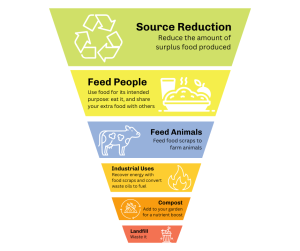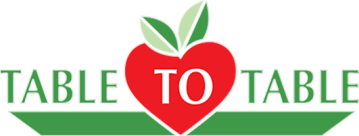Eat It, Feed It, Compost It
When it comes to food, the highest and best use is to eat it. When eating food is not possible, we turn to other uses for food that are better options than landfilling. This month, Love Food, Fight Waste is highlighting the food hierarchy to delve into the best ways to manage food for people and the planet.
Monthly Topic Overview
The food hierarchy is helpful to break down all the different ways food can be managed and to identify which options are better than others, from a social, economic, and environmental perspective. Let’s break it down layer by layer.
#1 Source Reduction: Reducing food waste at the source (such as your home) is the best for you and the environment. When we eat the food we purchase, we save money and make less trash. There is a lot of energy, water, and other resources that go into growing and producing food, and when we eat it, we are making that whole process worth it!
- Take Action: Learn how to reduce food waste at the source by checking out our past monthly promotions listed above under “Program Timeline.”
#2 Feed People: When there is more food than what a home or business can realistically consume or sell, donate it to feed others! Depending on where you live, there are different options on how to donate.
- Take Action: Here in Iowa City, we have our food rescuers at Table to Table and CommUnity that do great work in this slice of our food hierarchy “pie.” Both organizations take nonperishable canned goods and fresh produce from gardens and Table to Table can accept leftover food from events. Donate or volunteer to make a difference!
#3 Feed Animals: When circumstances arise where food is unable to be distributed for people to eat, a great next use is to feed farm animals.
- Take Action: If you know of a consistent food source that fits into this layer of the food hierarchy, there may be a local farmer interested in receiving it! Visit Practical Farmers to find a farmer near you.
#4 Industrial Uses: When food cannot be eaten or fed to animals, it can be utilized to produce energy. This is usually at the commercial or industrial scale.
#5 Compost: Composting is a great option when food cannot be utilized in the above, and is especially useful for non-edible types of food waste such as banana peels, eggshells, and coffee grounds. Composting is the process of facilitated decomposition in which food scraps and other organic materials are made into compost, a nutrient-rich soil amendment. Compost can be added to your yard or garden to give your soil a nutrient boost.
- Take Action: For information on composting at home, curbside, or directly at the Compost Facility, visit the City of Iowa City’s food waste web page.
#6 Landfill: As a last resort option, food waste is legally allowed to be landfilled in most locations. This is considered the least recommended option because of many reasons. Organic material, such as food, in a landfill environment where there is no air or light produces a potent greenhouse gas known as methane. Throwing food away also wastes all the resources that went into growing and making that food in the first place.
Activity
- If you compost:
- Look in your compost bin to see what different items have been thrown in. Are the food items non-edible, like coffee grounds, or are they food items that could have been eaten and instead were wasted, like moldy bread?
- If you don’t compost:
- Look in your trash can to see what has been thrown away. Do you see any food items, and if so, were they food items that could have been eaten and instead were wasted?
Resources
- EPA’s information on food hierarchy and composting
- FoodPrint’s assortment of food waste reduction resources, including worm composting and regular composting tips, food waste reduction tips, and more!
Read more Love Food, Fight Waste topics, brought to you by Table to Table and the City of Iowa City.


